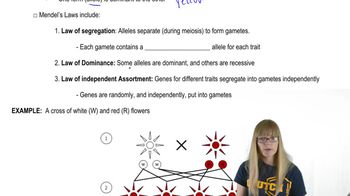Reciprocal crosses of experimental animals or plants sometimes give different results in the F1. What are two possible genetic explanations? How would you distinguish between these two possibilities (i.e., what crosses would you perform, and what would the results tell you)?
Table of contents
- 1. Introduction to Genetics51m
- 2. Mendel's Laws of Inheritance3h 37m
- 3. Extensions to Mendelian Inheritance2h 41m
- 4. Genetic Mapping and Linkage2h 28m
- 5. Genetics of Bacteria and Viruses1h 21m
- 6. Chromosomal Variation1h 48m
- 7. DNA and Chromosome Structure56m
- 8. DNA Replication1h 10m
- 9. Mitosis and Meiosis1h 34m
- 10. Transcription1h 0m
- 11. Translation58m
- 12. Gene Regulation in Prokaryotes1h 19m
- 13. Gene Regulation in Eukaryotes44m
- 14. Genetic Control of Development44m
- 15. Genomes and Genomics1h 50m
- 16. Transposable Elements47m
- 17. Mutation, Repair, and Recombination1h 6m
- 18. Molecular Genetic Tools19m
- 19. Cancer Genetics29m
- 20. Quantitative Genetics1h 26m
- 21. Population Genetics50m
- 22. Evolutionary Genetics29m
2. Mendel's Laws of Inheritance
Mendel's Experiments and Laws
Problem 4
Textbook Question
Which of Mendel's postulates are illustrated by the pedigree that you constructed in Problem 3? List and define these postulates.
 Verified step by step guidance
Verified step by step guidance1
Identify the key Mendelian postulates that are relevant to the inheritance pattern observed in the pedigree. Mendel's postulates include the Law of Segregation, the Law of Independent Assortment, and the Principle of Dominance.
Define the Law of Segregation: This postulate states that during the formation of gametes, the two alleles for a given trait separate so that each gamete receives only one allele. This ensures that offspring inherit one allele from each parent.
Define the Law of Independent Assortment: This postulate states that alleles for different traits assort independently of one another during gamete formation, provided the genes are located on different chromosomes or are far apart on the same chromosome.
Define the Principle of Dominance: This postulate states that when two different alleles are present in an organism, one allele may mask the expression of the other. The expressed allele is termed dominant, while the masked allele is termed recessive.
Analyze the pedigree constructed in Problem 3 to determine which of these postulates are illustrated. For example, if the pedigree shows a clear dominant-recessive inheritance pattern, the Principle of Dominance is illustrated. If the segregation of alleles is evident, the Law of Segregation is demonstrated. If multiple traits are analyzed and assort independently, the Law of Independent Assortment is relevant.
 Verified video answer for a similar problem:
Verified video answer for a similar problem:This video solution was recommended by our tutors as helpful for the problem above
Video duration:
3mPlay a video:
Was this helpful?
Key Concepts
Here are the essential concepts you must grasp in order to answer the question correctly.
Mendel's Law of Segregation
Mendel's Law of Segregation states that during the formation of gametes, the two alleles for a trait separate from each other, so that each gamete carries only one allele for each gene. This principle explains how offspring inherit one allele from each parent, leading to the genetic variation observed in traits.
Recommended video:
Guided course

Mendel's Laws
Mendel's Law of Independent Assortment
Mendel's Law of Independent Assortment posits that the alleles for different traits segregate independently of one another during gamete formation. This means that the inheritance of one trait does not influence the inheritance of another, allowing for a variety of genetic combinations in the offspring.
Recommended video:
Guided course

Mendel's Laws
Pedigree Analysis
Pedigree analysis is a diagrammatic method used to trace the inheritance of traits through generations in a family. It helps in visualizing how traits are passed down, identifying carriers of genetic conditions, and understanding the patterns of inheritance, which can illustrate Mendel's postulates in real-world scenarios.
Recommended video:
Guided course

Pedigree Flowchart
Related Videos
Related Practice
Textbook Question
495
views


